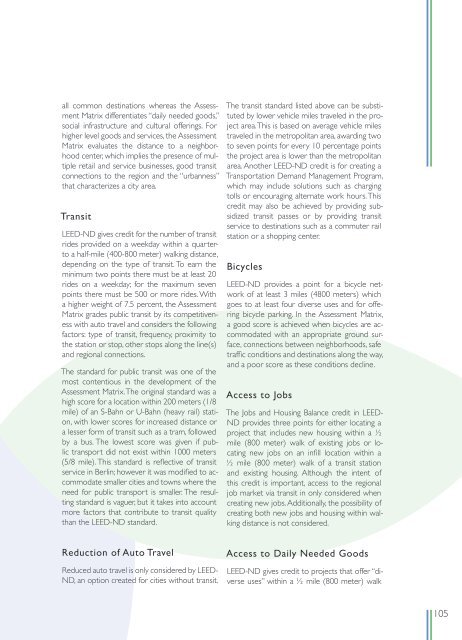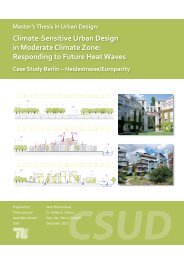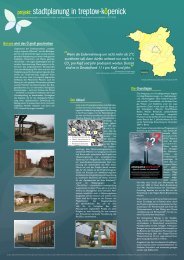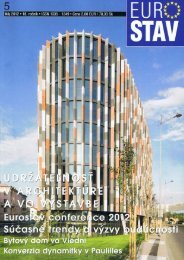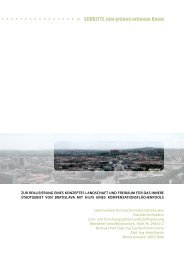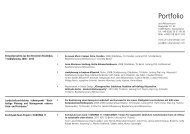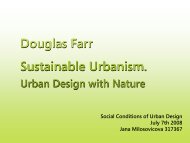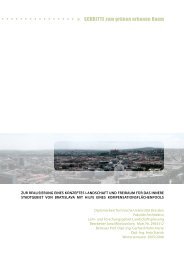Bausteine - Referate - Jana Milosovicova - Urban Design English
Bausteine - Referate - Jana Milosovicova - Urban Design English
Bausteine - Referate - Jana Milosovicova - Urban Design English
Erfolgreiche ePaper selbst erstellen
Machen Sie aus Ihren PDF Publikationen ein blätterbares Flipbook mit unserer einzigartigen Google optimierten e-Paper Software.
all common destinations whereas the Assessment<br />
Matrix differentiates “daily needed goods,”<br />
social infrastructure and cultural offerings. For<br />
higher level goods and services, the Assessment<br />
Matrix evaluates the distance to a neighborhood<br />
center, which implies the presence of multiple<br />
retail and service businesses, good transit<br />
connections to the region and the “urbanness”<br />
that characterizes a city area.<br />
Transit<br />
LEED-ND gives credit for the number of transit<br />
rides provided on a weekday within a quarterto<br />
a half-mile (400-800 meter) walking distance,<br />
depending on the type of transit. To earn the<br />
minimum two points there must be at least 20<br />
rides on a weekday; for the maximum seven<br />
points there must be 500 or more rides. With<br />
a higher weight of 7.5 percent, the Assessment<br />
Matrix grades public transit by its competitiveness<br />
with auto travel and considers the following<br />
factors: type of transit, frequency, proximity to<br />
the station or stop, other stops along the line(s)<br />
and regional connections.<br />
The standard for public transit was one of the<br />
most contentious in the development of the<br />
Assessment Matrix. The original standard was a<br />
high score for a location within 200 meters (1/8<br />
mile) of an S-Bahn or U-Bahn (heavy rail) station,<br />
with lower scores for increased distance or<br />
a lesser form of transit such as a tram, followed<br />
by a bus. The lowest score was given if public<br />
transport did not exist within 1000 meters<br />
(5/8 mile). This standard is reflective of transit<br />
service in Berlin; however it was modified to accommodate<br />
smaller cities and towns where the<br />
need for public transport is smaller. The resulting<br />
standard is vaguer, but it takes into account<br />
more factors that contribute to transit quality<br />
than the LEED-ND standard.<br />
The transit standard listed above can be substituted<br />
by lower vehicle miles traveled in the project<br />
area. This is based on average vehicle miles<br />
traveled in the metropolitan area, awarding two<br />
to seven points for every 10 percentage points<br />
the project area is lower than the metropolitan<br />
area. Another LEED-ND credit is for creating a<br />
Transportation Demand Management Program,<br />
which may include solutions such as charging<br />
tolls or encouraging alternate work hours. This<br />
credit may also be achieved by providing subsidized<br />
transit passes or by providing transit<br />
service to destinations such as a commuter rail<br />
station or a shopping center.<br />
Bicycles<br />
LEED-ND provides a point for a bicycle network<br />
of at least 3 miles (4800 meters) which<br />
goes to at least four diverse uses and for offering<br />
bicycle parking. In the Assessment Matrix,<br />
a good score is achieved when bicycles are accommodated<br />
with an appropriate ground surface,<br />
connections between neighborhoods, safe<br />
traffic conditions and destinations along the way,<br />
and a poor score as these conditions decline.<br />
Access to Jobs<br />
The Jobs and Housing Balance credit in LEED-<br />
ND provides three points for either locating a<br />
project that includes new housing within a ½<br />
mile (800 meter) walk of existing jobs or locating<br />
new jobs on an infill location within a<br />
½ mile (800 meter) walk of a transit station<br />
and existing housing. Although the intent of<br />
this credit is important, access to the regional<br />
job market via transit in only considered when<br />
creating new jobs. Additionally, the possibility of<br />
creating both new jobs and housing within walking<br />
distance is not considered.<br />
Reduction of Auto Travel<br />
Reduced auto travel is only considered by LEED-<br />
ND, an option created for cities without transit.<br />
Access to Daily Needed Goods<br />
LEED-ND gives credit to projects that offer “diverse<br />
uses” within a ½ mile (800 meter) walk<br />
105


